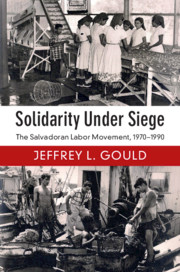Book contents
- Solidarity Under Siege
- Solidarity Under Siege
- Copyright page
- Dedication
- Contents
- Figures
- Acknowledgments
- People, Terms, and Acronyms
- Introduction
- 1 Tired of the Abuse
- 2 The Cost of Solidarity
- 3 The Last Chance
- 4 Labor Conflicts in Puerto El Triunfo, El Salvador, 1985
- 5 The Far Right and Fraud
- 6 Solidarity and Discord in the Labor Movement, 1984–1989
- 7 The Longest Strike in History
- Conclusion
- Epilogue
- Bibliography
- Index
2 - The Cost of Solidarity
The Salvadoran Labor Movement in Puerto El Triunfo and Greater San Salvador, 1979–1980
Published online by Cambridge University Press: 17 May 2019
- Solidarity Under Siege
- Solidarity Under Siege
- Copyright page
- Dedication
- Contents
- Figures
- Acknowledgments
- People, Terms, and Acronyms
- Introduction
- 1 Tired of the Abuse
- 2 The Cost of Solidarity
- 3 The Last Chance
- 4 Labor Conflicts in Puerto El Triunfo, El Salvador, 1985
- 5 The Far Right and Fraud
- 6 Solidarity and Discord in the Labor Movement, 1984–1989
- 7 The Longest Strike in History
- Conclusion
- Epilogue
- Bibliography
- Index
Summary
On November 10, 1977 some 1,500 Bloque Popular Revolucionario (BPR) activists gathered in the Mercado Central of San Salvador. The military regime had previously blocked their efforts to hold a demonstration in Cuscatlán Park in support of two textile worker strikes. Protected by the large crowds of people who shopped, worked, and congregated around the Mercado Central, the radical Left organization held a “lightning” demonstration and then marched to the Ministry of Labor several blocks away. They blocked off the street in front of the ministry and set up loudspeakers. When some militants saw that security agents were closing the iron doors, they rushed over to occupy the building. Although unarmed, they were able to take 100 employees hostage including the Minister of Labor and the Minister of Economy. They called upon the Minister of Labor to intervene in favor of the unions and to raise the minimum wage from 6.20 colones to 11 colones (US$4.40) a day. After 48 hours, following the minister’s promise to intervene, the BPR activists left the building.1 Across town, unionized workers occupied US-owned Eagle International, a glove manufacturer, in protest against low wages and anti-union repression. Union militants not aligned with the BPR held three US citizens hostage for 24 hours. The regime’s response was immediate. In the words of an US embassy observer: “These two incidents (the occupations and strikes) were among the factors that caused the government to promulgate the Law of Defense and Guarantee of Public Order, which among other provisions outlawed strikes and demonstrations. Steadily growing pressure from the wealthy elite and the military were contributing factors … Labor disturbances thus had been significant factors in the passage of the law.”2
- Type
- Chapter
- Information
- Solidarity Under SiegeThe Salvadoran Labor Movement, 1970–1990, pp. 57 - 87Publisher: Cambridge University PressPrint publication year: 2019

